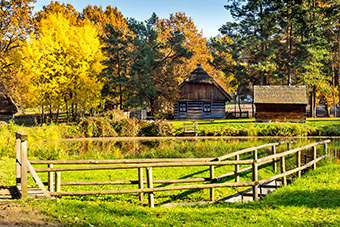With help from the European Regional Development Fund, renovation and modernisation works were carried out at the Radom Village Museum in the Polish province of Mazovia, ending its degradation and strengthening the museum’s position as an important historical tourist attraction for the promotion of the region’s cultural heritage.
Restoring history at Poland’s Radom Village Museum
- 24 June 2019
The project ended degradation of the Radom Village Museum and strengthened its position as an important historical tourist attraction which will promote the region’s cultural heritage.
The restoration has significantly increased the value of the homestead village museum. The project’s most important result is the renovation of the original wooden church of Saint Dorothy from Wolanów, which dates back to 1789, and the adjacent belfry from Wielgie. The church interior and infrastructure have been renovated and adapted to the needs of the disabled. The church’s surrounding area has been improved by establishing a cemetery, procession path and sacral band fence. New church bells and a baroque organ were purchased. Three bells were acquired and installed in the belfry.
In total, five historic buildings were given new, thatched roofs, replacing their original, decaying straw roofs. The village’s traditional windmill was restored to its former glory and function, expanding the museum’s exhibition capacity. Deteriorating, traditional agricultural machinery and vehicles were revamped and added to the museum’s unique and extensive collection of equipment.
Expanding educational activities
These renovation expanded the museum's educational offer and activities, both in a historical, material and non-material way. For instance, the restored windmill can be used to demonstrate its original function, by grinding grain. The acquisition and installation of a custom-built organ in the church allows for organ and choir recitals, string quartets and concerts in the church.
To increase the museum’s attractiveness among its younger visitors, project funds were used to open a separate recreational and educational miniature village, specially developed for children. The countryside playground from yesteryear features a small farmyard outfitted with traditional playground equipment, promoting the tradition and history of the Radom region. Group visits and school trips form an important segment of the museum’s target group.
Modernising one of Poland’s largest open-air museums
Aside from restoration and renovation, tourist services at the museum were modernised as well. At the original ticket office building, parking meters, ticket machines and a toilet for the disabled were installed, adapting the museum to present-day standards. A modern, multimedia kiosk was purchased to provide audio-visual presentations of the museum’s exhibitions, activities and history.
The Radom Village Museum was created to preserve generation of cultural heritage of the former population inhabiting the regions of Mazovia and Lesser Poland. One of the largest open-air museums in Poland, it covers a surface of over 36 hectares. Several dozen historical objects are juxtaposed throughout the area. There is a collection of 16 000 moving exhibits, including collections of folk art, vehicles such as carriages, farm cars and sleighs, and agricultural machinery. The domain has a dedicated beehive area with original beekeeping tools. The project has improved the museum’s image, access to its cultural resources and its relevancy for the region’s tourism industry.
Total investment and EU funding
Total investment for the project “Traditional Countryside Living: Modernising and Renovating the Cultural Landscape at Radom Village Museum” is EUR 1 669 031, with the EU’s European Regional Development Fund contributing EUR 716 399 through the “Mazowieckie Voivodeship” Regional Operational Programme for the 2014-2020 programming period. The investment falls under the priority “economic and social regeneration of deprived areas and increased access to health services”.

